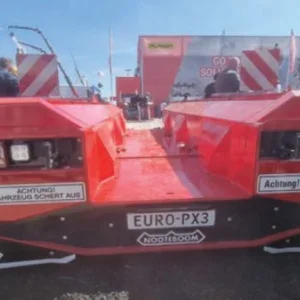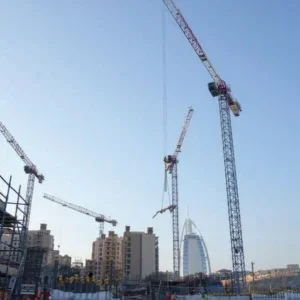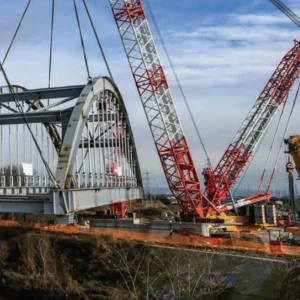The Atacama Large Millimetre/sub-millimetre Array (ALMA) is designed to study light from some of the coldest objects in the universe, which shine in radio wavelengths of around one millimetre. Scientists hope that it will help them to understand conditions in the molecular clouds where stars are born.
However, the low wavelengths of light that it will study are absorbed by water vapour in the atmosphere. In order to combat this, the European Organisation for astronomy in the Southern Hemisphere, ESO, and its international partners, chose to build the telescope in the driest part of the world, the Atacama plateau in Chile, parts of which have gone without rain for at least 400 years.
ALMA uses an array of 66 radio antennas, which will need to be carried from a base camp at 2,900m above sea level, to the observatory site, 5,000m high. The two transporters, designed by Scheuerle Fahrzeugfrabrik, will carry the antennas up to, and around, the site.
Once all the antennas are at the site, the transporters will still be needed regularly: the antennas will be moved between pads into configurations varying from 150m to 15km across, in order to focus the telescope.
Adrian Russell, the North American project manager for ALMA, says, “The ability to move antennas to reconfigure the observatory’s array is vital to fulfilling ALMA’s scientific mission. The operations plan calls for moving antennas on a regular basis to provide the flexibility that will be such a big part of ALMA’s scientific value. That’s why the transporters are so important.”
The project made three key demands of the Scheuerle designers: the transporters had to work at altitudes with very low oxygen levels, they must be able to work to precisions of a few millimetres, and they must climb more than 2km carrying their sensitive, 115t loads, on rough tracks with gradients of up to 10%.
The 20m long, 130t dwt, transporters are designed as a two-pronged fork, or a square-cornered ‘U’. The operator’s cab and engines are mounted on the front cross bar, with the wheels and an inclined elevator ramp on the two prongs. The cabin is suspended below the main structure, allowing the driver to watch the 14 wheels on each prong, and the load, without obstruction.
The transporter lifts the antennas by reversing towards them, positioning the elevator below the antenna’s lifting points. An adapter couples the antenna with the elevators on each ramp, and these are then hydraulically pulled up the incline. Lifting the antennas in this way ensures that the load is always spread over all 28 wheels.
Each ramp has 14 wheels on seven independently-steered axles, driven by a hydraulic transmission, powered by two 500hp engines. The engines need to be so powerful—each equal to that in a Formula 1 car—to cope with the low oxygen content of the air on the plateau. At 5,000m high, oxygen levels are so low that the diesel engines work half as efficiently as normal. The low oxygen levels pose a second problem: the needs of the drivers. In order to let them breathe, the cab’s seats have been designed to allow them to wear an oxygen cylinder.
The transporter needs to be as precise as it is powerful. On the tightest array configuration, there will only be a few metres space between antennas. The transporter’s independent steering means that it can rotate around the antenna as it lifts or lowers it, making the best possible use of the space available. A laser detection system on the transporter alerts the driver to possible collisions, and stops the transporter in an emergency. When the transporter is picking up or positioning the load, the driver will use a remote control, allowing him to watch the lift from the rear of the vehicle.
The transporters will travel at 20km/h (12 mph) when empty, and 12km/h (7.5 mph) with an antenna on board. The first will arrive in Chile by the end of 2007, with the second transporter joining it in the first quarter of 2008.
A rear view of the first ALMA transporter, showing the inclined elevators ALMA transporter rear view The ALMA transporter. The cab slung under the main body allows the driver to see the load and the wheels clearly. ALMA transporter front An artist’s impression of the ALMA transporter at work ALMA transporter cgi






